Last Updated on July 5, 2023 by Chase Manhattan
In this article I’ll cover everything you need to know about cleaning a mass air flow sensor. I’ll be including things like locating the mass air flow sensor, how to remove it and clean it, then reinstall it safely like a professional would.
To do this, I will give brief instructions on cleaning a maf sensor, answer some common questions, and then later go into more detail on how to clean a mass air flow sensor like a professional. You won’t need many tools, just the information that you can find here.
Here’s a brief guide on how to clean a MAF sensor:
- disconnect the car’s battery
- remove the engine air filter for easy access
- carefully remove the mass air flow sensor
- gently brush away any loose dirt from the sensor
- apply your maf sensor cleaner and allow it to soak for a few minutes
- brush again to agitate the maf cleaner and remove any additional dirt
- wipe sensor with a clean cloth
- reinstall the maf sensor
- reconnect the battery and start your car
Keep reading for the rest of the information you’ll need or skip ahead, using the table of contents, to the detailed MAF sensor cleaning guide.
- How to Clean Car Carpets Quick and Easy - July 10, 2024
- Can You Touch Up Clear Coat? Yes and No (Here’s Why) - November 25, 2023
- How To Wax A Car By Hand: A Comprehensive Guide - November 14, 2023
[Why You Shouldn’t Drive With a Bad Purge Valve]

[Pro’s Way to Cleaning Purge Solenoid Valve]
Quick Navigation
Can A Mass Air Flow Sensor Be Cleaned?
Yes, mass air flow sensors can be cleaned, it only depends on your experience and what materials and tools you have available to you. Keep reading to find out exactly what you’ll need and how to clean your MAF sensor without any cleaner should you find yourself in a pinch.
Otherwise, its important to know that cleaning a mass air flow sensor can become a part of your routine maintenance to avoid any unexpected issues.
What Can I Use To Clean A Dirty MAF Sensor?
Fortunately, mass air flow sensors can be cleaned with various methods. I prefer to use a dedicated MAF sensor cleaner as it is the most simple procedure, but there are methods involving other readily available materials.
Using a MAF Sensor Cleaner
If you have a MAF sensor cleaner on hand, it’s as simple as attaching the spray straw to the bottle, and spraying the MAF sensor’s silver plate, or silver wire, depending on the model and spraying the cleaner. Make sure you allow it to fully dry before reinstallation.
Cleaning a MAF Sensor with Alcohol
Using alcohol to clean a MAF sensor is a more rudimentary method. It will require a soft microfiber or a cotton swab. Uninstall the MAF sensor, apply your alcohol to your applicator of choice, scrub it across the sensor, and allow it to dry completely before reinstallation.
Cleaning a MAF Sensor with Brake Cleaner
Since brake cleaner is a caustic material, we’ll want to remove the MAF sensor entirely from the car and spray it away from any other components. Be careful not to get any in your eyes while spraying. Dry completely before reinstallation.
Cleaning a MAF Sensor without Cleaner
In a pinch, you can clean a MAF sensor without cleaner by using a bobby pin – or any small metal filament – to scrub the plate, or wire, free of any caked-on material.

[Guide to Cleaning a Catalytic Converter]
What Are The Symptoms of a Dirty MAF Sensor?
Here are the common symptoms of a dirty MAF sensor:
- a check engine light
- poor gas mileage
- an erratic idle
- hard starting
Check Engine Light
A check engine light is one of the more noticeable symptoms of a dirty maf sensor. The maf sensor monitors how much air is flowing through the air filter box, through the intake system, and down the intake manifold, so when this is out of balance, the car’s ECU (engine control unit) is usually the first to nice.
Poor Fuel Economy
Since the air entering the air intake system is not modulated as it should be, your car may try to overcompensate by adding more fuel. When this happens, you’ll notice an immediate and consistent reduction in its efficiency.
Erratic Idling
Following similar concepts, a bad MAF sensor will disrupt the air flowing through the air filter box with the engine running; this means that you will have an idle that fluctuates rapidly and will not hold a steady pace.
Hard Starting
You’ll see now that it all focuses on air flow. Sometimes your vehicle may struggle to start with a bad MAF sensor as the car requires a carefully calculated of air and fuel to start and then to keep the engine running. This is also known as ignition failure, as there is not enough air to ignite the fuel in the combustion chamber.
What Causes a Bad Mass Air Flow Sensor?
A bad MAF sensor is usually caused by dirt being caked onto the plate or wires inside the MAF sensor. The temperature of these elements when heated allows the dirt to build up on the wire or plate which creates an inadequate connection for the ECU to interpret the live data that it’s receiving.
Additionally, a bad air filter might prevent air from flowing into the system. This should be checked frequently as a part of your routine maintenance.
Where Is The Mass Air Flow Sensor Located?
For a large majority of vehicles, you can locate the mass air flow sensor inside the air intake system. More specifically, it’s behind the air box, behind the air filter, sitting between the intake manifold and the throttle body.
[EVAP Charcoal Canister Purge Valve Location]
Where is The Throttle Body?
For all cars, the throttle body is a crucial component of the air intake system; therefore, it will always be attached to the intake manifolds. Locate the throttle body by traveling upwards from the air filter box until you get right before the exhaust manifold.
How Does a MAF Sensor Work?
In short, a MAF sensor monitors the air flow coming through the air intake system.
The longer version, mass airflow sensors communicate with the ECU (engine control unit) by heating hot wires, or a silver plate, in accordance with the air it is reading. In return, these heated filaments pass signals to the ECU, which communicates how much air is present in the systems so that the ECU can provide an adequate amount of fueling.
For example, if there is a lot more air in the intake system the car may increase the fuel necessary to keep the engine running. On the converse, with not enough air the car may reduce the fueling significantly. In both cases, you will experience engine performance issues.
[How to Clean an Engine Bay the Right Way]

[What’s The Function of A Purge Valve Solenoid?]
How To Test a Mass Air Flow Sensor
Most professionals will use scan tools or a multimeter to test a mass air flow sensor, but you can also do this manually through the process of deduction.
Here’s how you can test a mass air flow sensor:
- put your car in park
- unplug the mass airflow sensor
- start the car
From here, we can determine if the MAF sensor is the problem or not. If your performance issues change or disappear, it’s likely the mass air flow sensor. If the problem continues, it’s likely to be other sensors or a different component entirely.
Testing a Mass Airflow Sensor with a Multimeter
Here’s how you test a mass airflow sensor with a multimeter:
- disconnect the mass airflow sensor
- set the meter to read low voltage
- connect the negative multimeter lead to the negative battery terminal
- connect the positive multimeter lead to the hot side of the MAF sensor
- start your car
[How to Test A Purge Valve Solenoid]
If you receive a reading between five and twelve volts, your mass airflow sensor is likely ok. Outside of this range, it may require a cleaning, replacement, or further investigation.
Testing a Mass Airflow Sensor with a Scan Tool
Testing a mass airflow sensor with a scan tool is simple enough. Simply turn your key to “accessory” and plug the scanner into the OBD port. The scanner will return with a code that you can check against online databases, or live data should you have more advanced software.
[Bad Gas Cap Symptoms for Cars]

[How To Bypass an EVAP Canister]
How To Clean A Mass Air Flow Sensor
Disconnect the Battery
Disconnect the battery so there will not be a chance of shorting any electrical components.
Unplug the Mass Air Flow Sensor
Simply unplug the mass air flow sensor, and place it in a secure area for the time being.
Spray With Solvent
You can use the same solvent you preferred from before, or use other cleaners that you have available. Rubbing alcohol is an alternative if you rather not spray any chemicals. Pay extra attention to the hot wires, or hot plate, to remove any lingering debris.
Dry Completely
Dry the mass air flow sensor completely. Check to make sure there is no remaining debris.
Reinstall the Sensor
Plug the mass air flow sensor back into its location. Be extremely careful not to damage any wires or connectors.
Start the Car
Start your car and check for a check engine light, any erratic idling, and that your vehicle is otherwise operating correctly.
[Recommended Read: How To Remove Scratches From a Car]

FAQ
How Long Does It Take for a Mass Airflow Sensor Cleaning?
This procedure can take 10-15 minutes, depending on how comfortable you are working under the hood. Make sure that you allow the engine to cool to an acceptable temperature before beginning.
What’s The Typical MAF Sensor Value?
A MAF sensors value entirely depends on the make and model of your vehicle. Past that, different models can have a different engine, so this is a factor as well.

